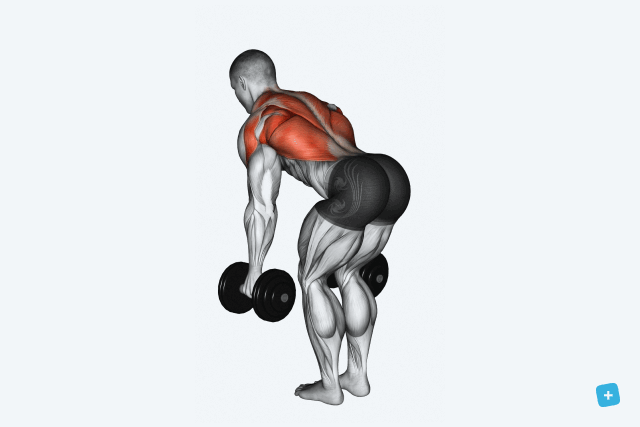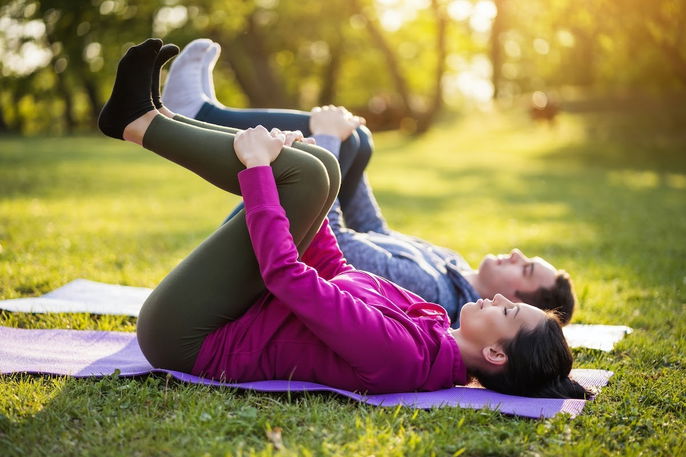A full-body dumbbell workout can incorporate exercises like bent-over rows, chest flys, and overhead presses. Using just dumbbells can offer many health benefits such as improving fitness and flexibility, promoting weight loss, increasing muscle mass, and increasing joint coordination and stability.
Dumbbell workouts are a great option to include in a strength training program, as they can target different muscle groups in the back, shoulders, legs or arms. A full-body dumbbell workout can easily be done at home, and dumbbells can even be swapped for bottles filled with water or sand.
Before starting a new dumbbell workout for the first time, you should see your doctor for a medical assessment to ensure you are fit to workout. Ideally, you should start training with a personal trainer, who can help to guide your form and movements.
How to start
A full-body dumbbell workout can be done 2 to 3 times per week. Each exercise can be done in 2 to 4 sets, for 8 to 15 repetitions, which will vary depending on the exercise.
Before starting to exercise, it is important to do warm-up. You can swing your arms up and down or out to your sides. You can also warm up your legs by going up and down stairs for 5 minutes.
Exercises list
Some exercises that you can incorporate into a full-body dumbbell workout include:
1. Bent-over row

The bent-over row is an excellent option to workout your upper back muscles, although it also targets the upper pecs, deltoids, trapezius and biceps. It can help to improve muscular strength and endurance, as well as your posture.
Also recommended: Complete Back Workout: 12 Back Exercises for the Gym (w/ Demos) tuasaude.com/en/back-workoutHow to perform: Stand with your legs shoulder-width apart and your knees slightly bent, leaning slightly forward. Your arms should be aligned with your body and your hands should be facing inward, holding a weight in each hand. Keep your back straight and your core braced.
Pulling the dumbbells upwards toward your chest, flexing your arms. Then slowly lower your arms toward the floor, straightening them fully. Exhale as you raise the dumbbells, and inhale as your lower them. You can repeat this 12 times, and perform 2 to 3 sets, with 1-minute rests between sets.
2. Chest fly

A chest fly is a dumbbell exercise with dumbbells that mainly targets the chest muscles, but also engages the triceps and deltoids. It can help with muscle toning and strengthening, but also improve motor coordination.
Check-out other chest exercises that you can perform at home.
How to perform: Lie on your back on the floor with your legs straight in front of you. Hold the dumbbells up at your shoulders, with your palms facing up. With your core braced, raise your arms and push the dumbbells above you, over your chest. Keep your elbows slightly bent and your wrists straight. Then lower your arms slowly until they touch the floor, keeping your elbows bent.
You can perform 3 to 4 sets with a maximum of 15 repetitions, resting for 30 seconds between sets.
3. Overhead triceps extension

The overhead triceps extension is a great exercise to strengthen and tone your triceps.
If you are looking to target the back of your upper arms, check out other tricep exercises you can perform.
How to perform: Stand with your feet shoulder-width apart and with a slight bend in your knees. Grab one dumbbell and hold it behind your head, with your elbow pointing to the ceiling. While keeping your elbow fixed at this position, straighten your arm and lift the dumbbell over your head. Lower the dumbbell back down to return to your starting position.
Repeat this exercising 10 to 12 times, performing 2 to 3 sets.
4. Hammer curl

Hammer curls are a very effective dumbbell exercise for targeting the biceps and brachialis muscles.
Also recommended: Bicep Workouts at Home: 7 Best Exercises (w/ Pics) & Cooldown tuasaude.com/en/biceps-workout-at-homeHow to perform: Hold with a dumbbell in each hand with your palms facing inward and your arms straight down by your side. Then flex your elbows, and raise the dumbbells to your shoulder. Slowly lower them, keeping your core braces and your shoulder and wrists fixed throughout this movement. Exhale as you raise the weight, and inhale as you lower.
You can perform 3 to 4 sets of 8 to 12 repetitions each, with 60 to 90 seconds of rest between sets. A variation of this exercise is to raise your arms one at a time in an alternating manner.
5. Arnold press

An Arnold press targets the anterior and lateral deltoid muscles, but also works your triceps, trapezius and upper pectoral muscles. It a great option for people looking to tone their shoulders.
Check-out other shoulder exercises you can incorporate into your plan.
How to perform: sit on a bench or chair and place the weights in front of your face, with your palms facing you. With your back straight, lift the dumbbells over your head, turning your palms forward as your raise your arms. Return to the starting position, turning your palms toward your face again as your lower your arms.
You can do 2 to 3 sets of 12 to 15 repetitions, with a 30-second break between sets.
6. Dumbbell squats

A squat is a complete exercise that works the glutes, thighs, calves, hamstrings and abdomen. It can strengthen and lengthen you muscles, while also improving your flexibility.
How to perform: Stand with feet shoulder-width apart. Keep your back straight and the abdomen contracted. Hold one dumbbell with both hands in front of your body. Lower yourself to the ground, bending your knees and keeping the weight close to your body body. Learn your torso slightly forward as you lower to the ground and drive your glutes back, as if you were going to sit on an invisible chair. Stop when your knees reach a 90-degree angle, being sure now to extend your knees beyond your toes. Return to your starting position.
Do 3 sets of 20 repetitions with a 1-minute rest between sets.
Cool Down routine
After your full-body dumbbell workout, you should stretch to promote relaxation, toning, flexibility and circulation. A proper cool down routine can also help to prevent injuries.
Some stretching exercises you should perform after a dumbbell workout include:
1. Arm stretch

Stretching your arms behind you can help to lengthen the muscles in your arms, chest and shoulders to promote circulation and recovery.
How to perform: In a standing position, clasp your hands behind your back and stretch your arms behind you. Then raise your arms to your midback and hol for 20 to 30 seconds. Be sure to feel the stretch in your biceps, and to stretch within your range of motion.
2. Lying leg stretch

A leg hug should be done on the floor, so that you can lengthen the muscles in your glutes, hips, legs and lower back.
How to perform: Lie on your back on the floor face up and bend your knees, holding them up to your legs. Wrap your arms around your calves and hug your legs for 20 to 30 seconds. Repeat the movement 3 times. Another option is to hug one leg at a time, keeping the other leg straight if possible.






























